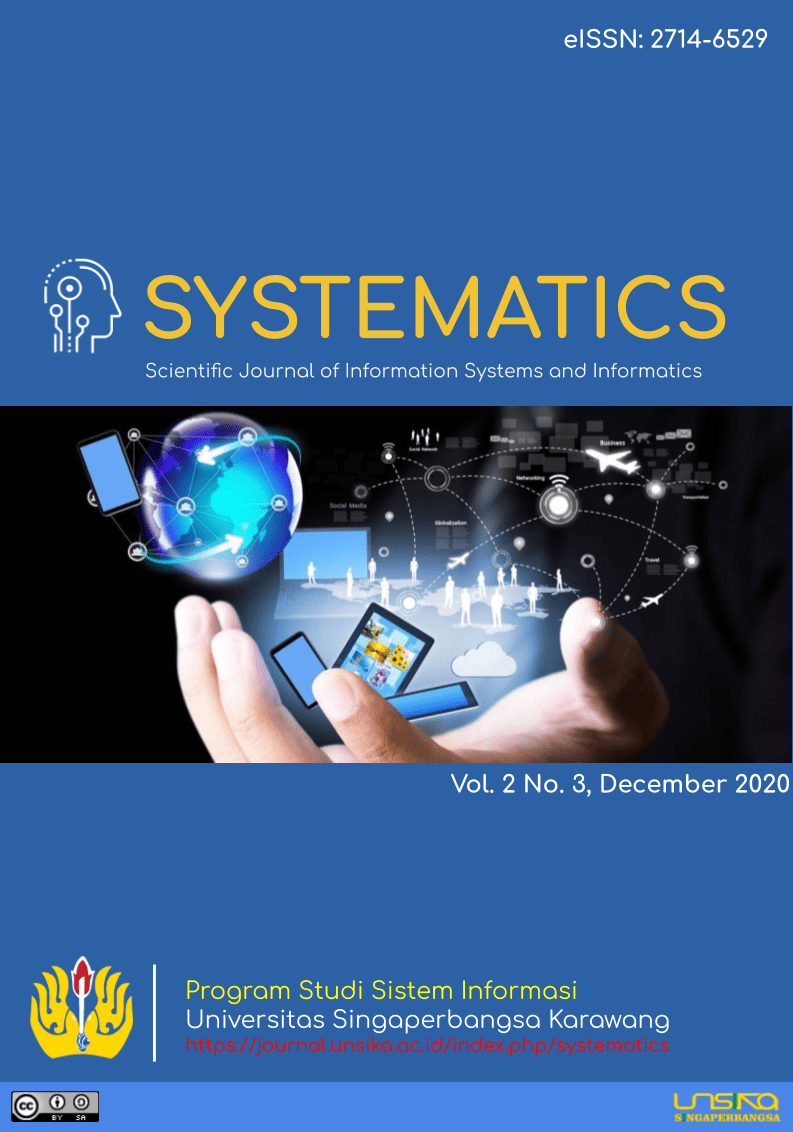Implementation of Quality of Service (QoS) with Traffic Shaping Method in Wireless Internet Area as Network Optimization
Abstract
This research is engaged in wireless internet networking. Wifi-based area internet service providers with a fairly large number of customers require extra services to keep customers subscribed to the internet. The problem that always appears as a job is the unstable quality of the internet to customers. A lot of customers and concurrently, when internet access is often a connection down and often have a hank on the router. All this is due to network management that is not regulated in such a way that is unstable. This study proposes the application of quality of service with traffic shaping techniques as a form of wireless internet network management. To find out the results, the study conducted a test before the method was applied, and the test after the method was applied. The results of the test data indicate that there are differences in the quality of the wireless network, and with the implementation of the traffic shaping method, the quality of the wireless internet network is more stable and reliable by customers even when traffic is very congested.
Downloads
References
C. A. Pamungkas, “Manajemen bandwith menggunakan mikrotik routerboard di politeknik indonusa surakarta,” Inf. Politek. Indonusa Surakarta, vol. 1, no. 3, pp. 3–8, 2016.
“Survei APJII yang Ditunggu-tunggu Penetrasi Internet Indonesia 2018,” Asosiasi Penyelenggara Jasa Internet Indonesia (APJII), p. 6, 2019.
T. Puspitasari, R. Maulida, T. Tanjung, T. Hardi, and W. Haryono, “Penggunaan Internet yang Sehat dan Aman Di Era Milenial SMK PGRI 31 Legok,” KOMMAS J. Pengabdi. Kpd. Masy., vol. 1, no. 1, pp. 41–50, 2020.
M. R. Ramadhani and A. R. Pratama, “Analisis Kesadaran Cybersecurity Pada Pengguna Media Sosial Di Indonesia,” Automata, vol. 1, no. 2, 2020.
F. Andiarna, L. P. Widayanti, I. Hidayati, and E. Agustina, “Analisis Penggunaan Media Sosial Terhadap Kejadian Insomnia Pada Mahasiswa,” PROFESI (Profesional Islam. Media Publ. Penelit., vol. 17, no. 2, pp. 37–42, 2020.
Sofyan, “Penggunaan Internet dan Kinerja Dosen Pegawai Negeri Sipil Kopertis Wilayah III,” J. Ilmu Komun., vol. 9, no. 1, pp. 76–86, 2011.
R. S. Sasmita, “Pemanfaatan Internet Sebagai Sumber Belajar,” J. Pendidik. dan Konseling, vol. 1, no. 2, pp. 117–121, 2020.
I. K. Rachadika and M. I. P. Nasution, “Pemanfaatan Internet Terhadap Perkembangan Industri Perbankan pada Bank BCA,” Al-Kharaj J. Islam. Econ. Bus., vol. 02, no. 1, pp. 34–48, 2020.
I. I. P. Heryani, M. Simanjuntak, and A. Maulana, “Perilaku Penggunaan Internet Banking Sebagai Alat Transaksi,” J. Apl. Manaj. dan Bisnis, vol. 6, no. 1, pp. 86–95, 2020.
A. P. Hasibuan and D. Anubhakti, “Implementasi E-Commerce Menggunakan Content Management System ( Cms ) Untuk Meningkatkan Penjualan pada Toko JHM Herbal,” J. IDEALIS, vol. 3, no. 1, pp. 157–163, 2020.
F. P. Ramadhan et al., “Penerapan E-Commerce Untuk Meningkatkan Penjualan Menggunakan Business Model Canvas Studi Kasus : Toko Bayu Sports,” J. IDEALIS, vol. 03, no. 01, pp. 492–497, 2020.
hasri I. A. Syamsu, L. Lukman, and M. N. H. Nurdin, “Pengaruh Umpan Balik Positif Media Sosial Terhadap Self Esteem pada Mahasiswa Pengguna Instagram Di Universitas Negeri Makasar,” J. Psikol., vol. 5, no. 1, p. 2019, 2019.
A. K. Karo, Y. Azhar, and M. Maskur, “Sistem Pakar Diagnosa Penyakit Paru – Paru Menggunakan Metode Case Base Reasoning Pada Telegram Bot,” JurnalRepositor, vol. 2, no. 6, pp. 711–716, 2020.
A. Solehudin and G. Garno, “Prototype API pada Aplikasi Pembatasan Akses Internet dengan Pemanfaatan Hak Akses User Profile Hotspot,” J. Rekayasa Inf., vol. 6, no. 2, pp. 50–53, 2017.
F. Farid, T. A. Gani, and M. Melinda, “Optimalisasi Kinerja Jaringan Komputer Multi Layanan dengan Metode Traffic Shaping pada Mikrotik,” KITEKTRO, vol. 1, no. 2, pp. 78–86, 2012.
S. Budin and I. Riadi, “Traffic Shaping Menggunakan Metode HTB (Hierarchical Token Bucket) pada Jaringan Nirkabel,” Bul. Ilm. Sarj. Tek. Elektro, vol. 1, no. 3, p. 144, 2019.
H. Kusbandono and E. M. Syafitri, “Penerapan Quality Of Service (QoS) dengan Metode PCQ untuk Manajemen Bandwidth Internet pada WLAN Politeknik Negeri Madiun,” J. Comput. Inf. Syst. Technol. Manag., vol. 2, no. 1, p. 7, 2019.
I. I. Wirahmad and Z. Arifin, “Implementasi, Implementasi Model Pembelajaran ATI (aptitude treatment interaction) Untuk Meninggkatkan Hasil Belajar dan Aktivitas Belajar Siswa Materi Geometri Ruang Kelas XII.IPA.1 SMA Negeri 4 Kota Bima Tahun Pelajaran 2019/2020,” Pedagog. ( J. Pendidik. ), vol. 2, no. 1, pp. 46–56, 2020.
A. Sukma, R. Kurnia, and F. Febrialismanto, “Pengaruh Media Alphabet Smart terhadap Kemampuan Mengenal Huruf Anak Usia Dini,” Aulad J. Early Child., vol. 3, no. 1, pp. 29–35, 2020.
A. Lasmana, R. Qadar, and M. Syam, “Pengaruh Model Pembelajaran OIDDE terhadap Kemampuan Berpikir Kritis Siswa Di SMAN 2 Berau Pada Materi Suhu dan Kalor,” J. LITERASI Pendidik. Fis., vol. 1, no. 1, pp. 11–18, 2020.
Downloads
Published
How to Cite
Issue
Section
License
Copyright (c) 2021 SYSTEMATICS

This work is licensed under a Creative Commons Attribution-ShareAlike 4.0 International License.
Authors who publish with this journal agree to the following terms:
- Authors retain copyright and grant the journal right of first publication with the work simultaneously licensed under a Creative Commons Attribution-ShareAlike 4.0 International License. that allows others to share the work with an acknowledgement of the work's authorship and initial publication in this journal.
- Authors are able to enter into separate, additional contractual arrangements for the non-exclusive distribution of the journal's published version of the work (e.g., post it to an institutional repository or publish it in a book), with an acknowledgement of its initial publication in this journal.
- Authors are permitted and encouraged to post their work online (e.g., in institutional repositories or on their website) prior to and during the submission process, as it can lead to productive exchanges, as well as earlier and greater citation of published work (See The Effect of Open Access).







